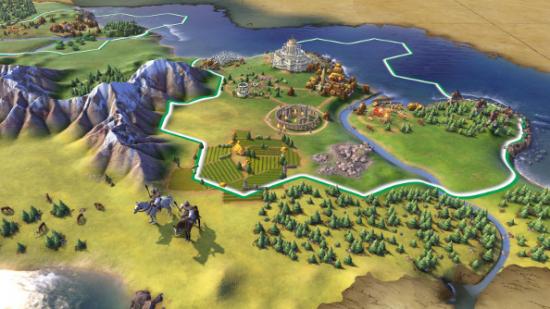I am a man who has played Civilization VI, which is simultaneously surprising – we only learned of its existence a couple of weeks ago – and sad, because a strict turn limit was imposed. I was given 60 of them and offered fleeting control over China, free to go to war, research ancient advances in technology and culture, and explore a small map containing three other civilisations.
Will Civilization VI take its predecessor’s spot on our list of the best strategy games on PC?
There was a lot I managed to fit into my brief reign, but what will stay with me is the moment where my buddy, Teddy Roosevelt, burned our friendship. I can no longer look at a bushy moustache without feeling betrayed.
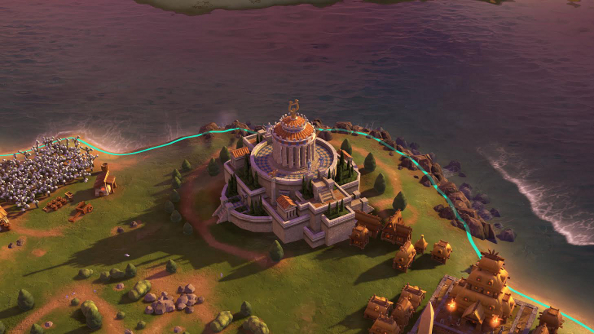
Here we are again – one settler, terra incognita all around me, all of history waiting to be experienced. Luckily I don’t need to waste my time looking for a great birthplace for my first city, as my settler is standing smack bang in the middle of a cracking spot for the capital. A mountain range to the west; flat, farmable land under the mountains; the ocean to the east – it’s a prime, beach-front location.
Beginning construction reminds me that Civilization VI does research a bit differently from its predecessors, taking into account more than just a civ’s science output. Every single technology has an objective attached to it, clearly displayed in the tech tree, which cuts down the number of turns it will take to research it. These objectives are a broad bunch, encouraging you to explore every aspect of the game. Meeting new civs, fighting barbarians, building, recruiting – they all help speed up research.
Since my first city is on the coast, I get a bump in seafaring, so when the time comes for me to pick that technology to focus on, when I start to look out across the sea and think to myself, “Yes, I would like to send some ships out there,” then I won’t have to wait for too long before that’s a reality.
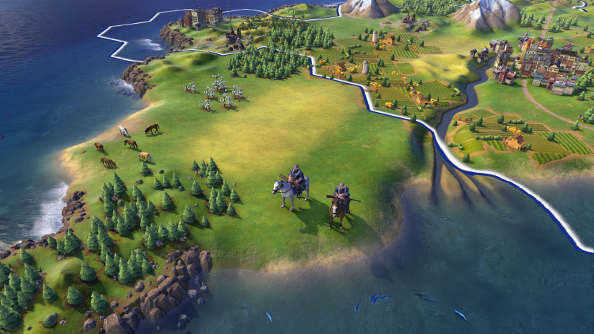
I find myself picking research priorities in a very different way when compared with Civ V. This time, when I look at the tech tree, I’m scanning for technology I’ve already got a headstart on, while planning for the future by giving myself these personal quests. If I build some improvements around my city, I think to myself, I can research irrigation faster. If I fight neighbouring barbarians, I can research new units.
Not being a warmonger, however, I start with those hex improvements, but not before recruiting a scout and sending him out with his dog to explore the unknown world that surrounds us. This is probably a good time to mention that Civilization VI is quite the looker. I actually liked the simple, bright style that was revealed in the first screenshots, but they don’t really do the game justice.
The map is significantly more legible than its predecessor, especially when it comes to cities. Slightly larger units, colour-coordinated buildings, the unstacked sprawl – they all make it just that bit easier to understand what you’re looking at, especially when you’re planning a siege and trying to pick targets. Besieging a city isn’t all about focusing on one hex now. The city centre is the most fortified location, so it pays to damage infrastructure and districts before marching to the heart of a settlement.
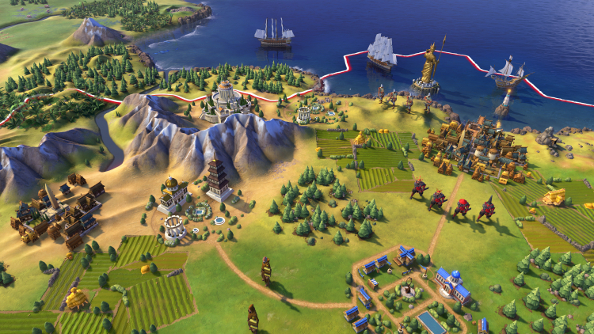
Fog of war has changed as well. Explored areas outside of your zone of control or the vision of your units take on the appearance of a weathered map, vaguely depicting the terrain, while drawings reveal what kind of resources the tiles contain. It’s still very legible, but with some historical flair.
While my scout evades barbarians and searches for new civilisations and resources, I get to work making my first city the envy of the world. First, I recruit a builder. Civ VI’s builders are essentially workers from the previous games, but much better at their jobs. They don’t take cigarette breaks or take time for lunch, so there’s no waiting around for them to finish improving a hex – their projects are constructed immediately. There’s a price for this efficiency, however: a builder unit only has three charges – to start with – and once they are used up, the unit is no more.
This change has forced me to acknowledge some bad habits that I’ll need to shake if I ever want to build an empire that can stand the test of time. See, I always need to have my workers or builders or whatever constantly constructing improvements; always building roads and farms and mines. I think it’s because they take, or took, so bloody long to finish their work, so I was always paranoid about wasting time. And that’s why I built three farms around my city, and when it came time to construct my first mine, I didn’t have any builders left.
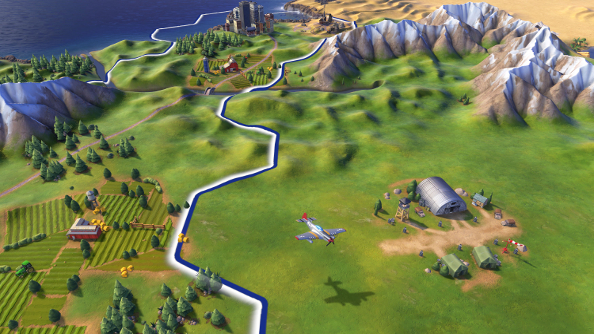
There’s another wrinkle: space is at a premium. Now that cities have been unstacked there’s more competition for it. Districts that allow you to expand and specialise cities and wonders all take up hexes, so if you’re plonking down farms and mines everywhere, you’re probably going to end up building over them.
Despite a few hiccups due to learning the ropes all over again, my city is coming along nicely, and it’s time to think about the big picture of managing my empire rather than just a single settlement. That’s where civics come in. Civics are loosely like Civ V’s social policies, but are now part of what is essentially a second tech tree, specifically dealing with culture and governance. Unlocking advances in this tree makes different forms of government available, as well as expanding the range of policy cards you have in your deck.
Yes, there’s a deck building component to Civ VI. It’s all the rage right now. I sound facetious, but I actually like it a lot. Even after only 60 turns, I had more cards than I knew what to do with, which gave me a slew of potential bonuses running the gamut from perks that made dealing with barbarians easier to cards that increased production in every city I owned. If I want to go to war, there are cards that can help me; if I want to focus on religion, there are cards for that, too. Every possible focus has a multitude of cards that assist in that temporary specialisation.
Civilization VI might be laden with new systems, but it’s not an alien experience. As my first wonder, Stonehenge, nears completion, I realise this to my dismay. A notification pops up, informing me that an unknown civilisation has completed construction of it before me. The scoundrels. All that time wasted. But that’s always the risk, isn’t it? There’s always someone that might beat you to it.
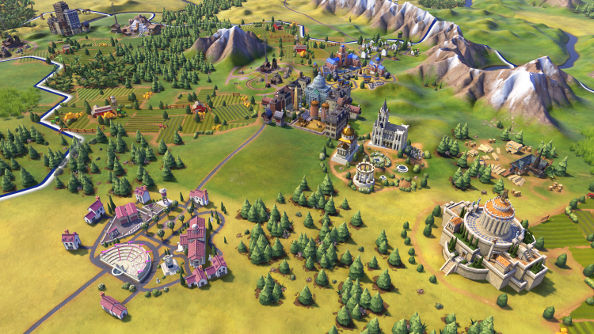
Thankfully, Stonehenge isn’t the only wonder that I can construct right now, but unlocking the tech that allows you to build a specific wonder isn’t the same as being able to actually erect it. Civ VI’s wonders have extra prerequisites that connect these grand projects ever so slightly to their historical counterparts, while also giving greater meaning to the fact that they must be placed on hexes rather than automatically appearing inside or around the city. The Pyramids, for instance, can only be constructed on a desert hex, so I’ll need to build a new city if I want them.
Instead of the Pyramids, I decide to settle for the almost as impressive Hanging Gardens. While wonders can take a while to construct, I’ve got a card that speeds up the building of those both ancient and classical, so before too long my gorgeous gardens appear, and I’m rewarded with a quick wonder scene that shows it being raised from the earth. And there’s a cosmetic benefit to wonders being given their own hexes: they’re now absolutely massive. Indeed, the Hanging Gardens dwarf even my fledgling city, dominating the region. Everyone is going to know how brilliant the Chinese are.
While I’ve been focused on making my city the sort of place tourists would love, my diligent little scout and his dog have finally discovered other civilisations. There’s America, ruled over by Teddy Roosevelt, and Egypt, Cleopatra’s domain. Teddy seems like a nice fella, but Cleo’s unlikely to ever be my mate, given that she promptly starts slagging me off. See, leaders each have a historical trait that informs their goals and interactions with other civilisations. Teddy won’t like you if you start a war on his continent, while Cleo seems to abhor weakness, and I’m definitely weak, at least in regards to military power.
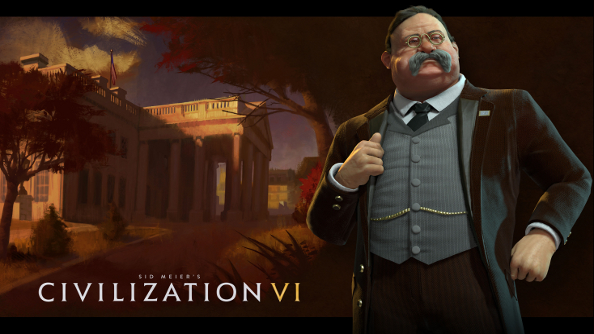
I’ve been avoiding confrontation because I’m far too busy building and generally being a lovely, friendly ruler. This has become increasingly hard as barbarians have started to flex their muscles. The barbarians are still dicks, making friends with nobody, always out for a scrap. They’re a bit smarter this time around, however. They’ve sent scouts to check me out, and now that they know I’m not a hard man, the barbarian settlement to the south has started churning out boats, hassling my coastal city and my units.
My neighbouring civs are of greater concern, however. I’m playing on a very small map, and clearly Firaxis have set it up so that, within 60 turns, the chances of war are high. Next to me, a fellow player has been engaged in a war with Cleo since turn 20. I’m expecting things to heat up. While we’re still at peace, however, I explore less aggressive interactions.
Civilization VI will launch with both espionage and religion, unlike its predecessor. Aside from creating my pantheon and selecting a bonus, I don’t have much time to fiddle with fundamentalism, but I’m already very intrigued by espionage. The first tier of information gathering is gossip. By talking, trading and sending an envoy, I get to know Teddy and his people. It’s the sort of stuff that one might learn in a market, rather than state secrets, but more advanced espionage options will open up as a civilisation progresses.
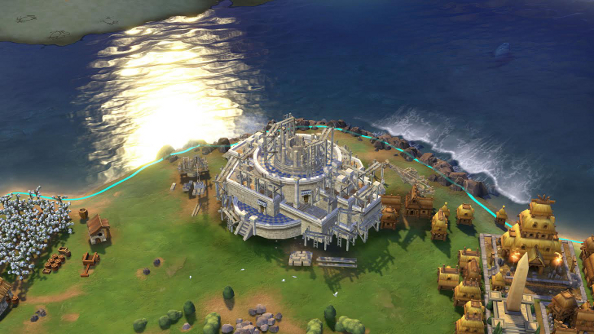
I like Teddy. I like his moustache and the way he welcomes me into the White House with open arms. I want to share with him the luxurious goods of my people, to show what a great guy I think he is. So I recruit a caravan and send it to his capital. Trade is another system that feels a little bit more connected to history. When caravans link up cities, roads appear between them, making travel across that route faster. It’s a more organic, logical approach to creating that transport network, and frees up builders from the tedium of plastering paths across the entire map.
My dreams of trade are dashed against the rocks of war. Before I can link our empires up, Teddy betrays me. He doesn’t actually like me all that much, it turns out. It’s a surprise war, an attack of opportunity, because ol’ Teddy noticed one of my settlers inching their way up the coast to a lovely new area filled with resources, right next to the Great Barrier Reef, one of the game’s natural wonders. Obviously Teddy had his eye on the area too, and it is close to his own empire.
Obviously I’m upset. It’s not just that I thought we were pals, I’m also still quite weak. Teddy has chariots, and I confess I don’t even know what a wheel is yet. Seriously. What the hell is it? Is it a type of bread? Anyway, I see his units heading to my capital on their weird, alien bread vehicles. He’s sent some warriors to capture my settler, too. But no! I’m not letting him have my units.
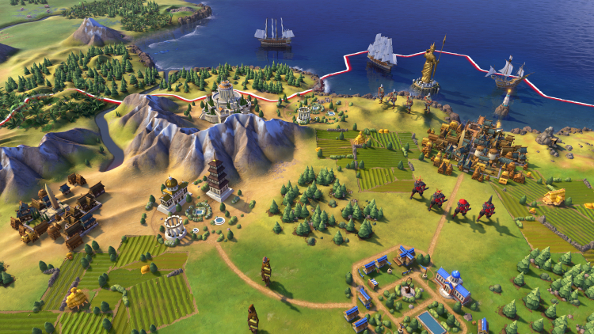
My puny little settler is vulnerable. All Teddy needs to do is move his warrior over to that hex and I’ll lose the unit. Thank goodness for escorts, then. Not only can units of the same type be combined to create corps and armies, support units like settlers can merged with the troops so they can safely be escorted to their destination. I link my settlers up with a warrior, and when Teddy attacks, I manage to fend his forces off, giving me another turn to build a city. With it built, the Americans are now no longer hunting a lone settler, but having to deal with a new settlement, complete with a garrison of warriors, the settlers’ escort.
It’s a small victory in what may have developed into a trickier war. Teddy obviously has military superiority, but I’m also just about to get chariots of my own, and I’m already recruiting some helpful spearmen. Sadly, before I can go on the offensive, I notice the number of turns. 60. The war will have to continue in my head, for my time is up.
A couple of hours with a Civilization game is but a brief taste, but I did manage to explore everything from wonder-building to international intrigue. And it’s all looking, from this glimpse of a vertical slice, meaningfully different from previous Civs. I didn’t gel with the UI, which didn’t always give me the information I needed, when I needed it, but 60 turns also wasn’t enough time to shake off my memories of Civ V’s UI, which is still clear in my mind. Everything else, though, seems fat with promise, and I confess that I ache for one more turn.
